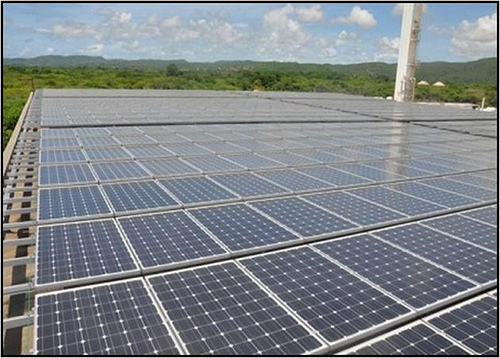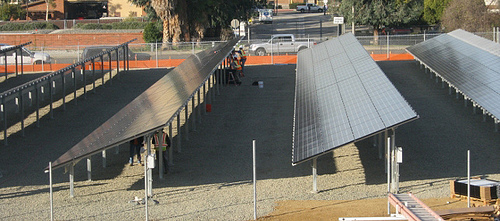
This solar electric system, funded in part through USDA’s Rural Energy for America Program has reduced a Puerto Rican Paint company’s electric bill from $180,000/year to zero.
On September 13, Master Paints & Chemical Corporation located in the Municipality of Guayanila, Puerto Rico realized their goal when they became independent of the use of fossil fuel sources energy.
Master Paint & Chemical Corp is a local rural paint manufacturer that employs 260 people. This company represents one of the main jobs sources in the municipality. In the past, the cost of electricity totaled more than $180,000 annually. Energy savings in this area became a priority to grantee. With the installation of this system, the company will save 100 percent in yearly energy costs. Read more »

A portion of the 1,288 solar panels on 1.5 acres, which are connected to a 250 kW inverter to produce an estimated 600,000 kW hours of alternating current each year at the Forest Service’s San Dimas Technology Development Center. (Recsolar photo)
About 25 miles east of Los Angeles, the Forest Service’s San Dimas Technology Development Center is ready to start operations using a photovoltaic array to supply the buildings there with a potential 600,000 kilowatt hours of current each year.
“This system has made the San Dimas Center a ‘net-zero energy’ facility, the first in the U.S. Department of Agriculture,” explained Forest Service Chief, Tom Tidwell. “This means the facility produces more renewable energy per year than the total energy used by the facility.” Read more »

Students at Barack Obama Elementary School, near St. Louis, learn about healthy food choices through gardening.
Acting Deputy Undersecretary for Rural Development Judith Canales recently had the opportunity to visit Missouri’s new Barack Obama Elementary School located in a suburb of St. Louis. The school district has started the Barack Obama Elementary Healthy Food Pilot Project where the objective is to serve a healthier school breakfast and lunch menu. As part of this pilot project, the Farm to School Program is being incorporated to bring in more locally grown produce. The elementary school has also created a school garden in partnership with community members, community-based organizations, and a local community gardening group. It appears that they are on the right track! Read more »
Late last week, Agriculture Secretary Tom Vilsack went to Omaha, Nebraska to discuss the President’s “All of the above” energy strategy, and meet with wind energy and rural development officials. Speaking to members of the American Coalition for Ethanol, he said that while the drought is severe and the Obama Administration is moving to help affected farmers and ranchers, we won’t know the impact of this drought until harvest time – but we do know that working together, we will get through this challenge.
The Secretary noted that Nebraska has been hit hard by drought. Today, USDA declared an additional 172 additional counties across the United States as primary natural disaster areas due to drought – and as of today, all of the State of Nebraska is covered by primary or contiguous disaster designations for drought.
Read more »

Agricultural Research Service chemist Tsung Min Kuo and technician Karen Ray convert vegetable oil into antifungal agents and other value-added bioproducts.
This post is part of the Science Tuesday feature series on the USDA blog. Check back each week as we showcase stories and news from USDA’s rich science and research profile.
Emerging bioenergy systems hold the promise of helping to reduce our dependence on foreign oil, increase economic prosperity, and reduce greenhouse gas emissions. The National Renewable Fuel Standard mandates the production of 36 billion gallons of biofuels be produced annually by 2022; of which 16 billion gallons must come from fuels that are not corn-based ethanol. These fuels, produced from the conversion of grasses, wood, and oilseeds and other biomass, must be produced in a sustainably and economically efficient manner. To meet this goal, USDA has developed a Bioenergy strategy, focused on research, development, education, and extension. As part of USDA’s Office of the Chief Scientist series of white papers on the Department’s research portfolio, this plan aligns USDA’s biofuels research with the goals of President Obama’s Blueprint for a Secure Energy Future. Read more »
As drought continues across America, President Obama and I continue doing all we can to help farmers and ranchers. Last week, at the President’s direction, I convened a meeting of the White House Rural Council to ensure we’re doing all we can – and we’ll meet again to discuss drought in the coming days.
We’ll also continue to call on Congress to pass a Food, Farm and Jobs Bill as soon as possible, to give USDA more tools to help and to give more certainty to producers in this difficult time.
Meanwhile, at USDA we continue our work to help grow the economy and create jobs. This includes our support for innovative producers and rural businesses who are already working hard to boost the emerging bio-economy.
From household products made of homegrown crops, to remarkable advanced biofuels that are powering America’s ships and aircraft, the bio-based economy is strengthening our nation while bringing more jobs and economic security to rural America.
Today, more than 3,000 companies are producing more than 25,000 biobased products made from renewable sources grown here at home, and supporting 100,000 American jobs. These companies are developing a wide variety of products – from cleaners and paints to construction materials – for use at home, at work, and by industry. Read more »




